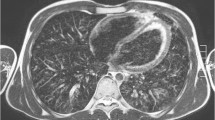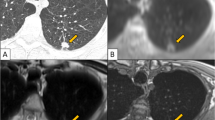Abstract
The purpose of this study was to evaluate the feasibility of high-field magnetic resonance imaging (MRI) of the lung using a T2-weighted fast-spin echo (TSE) sequence. Comparison was made with helical computed tomography CT findings in patients with diffuse pulmonary diseases. Prospective segment-wise analysis of high-field MR imaging findings in 15 patients with diffuse pulmonary diseases was made using helical CT and HRCT as the standard of reference. The MR studies were performed on a 3.0-T whole body system (Intera 3T, Philips Medical Systems) using a T2w TSE sequence with respiratory and cardiac gating (TE 80 ms TR 1,500–2,500 ms; turbo factor 17; 22 slices with 7/2-mm slice thickness and gap; 256×192 matrix). MR artifacts were graded on a three-point scale (low, moderate, high). Lung MR studies were prospectively analyzed segment-by-segment and diagnosed as healthy or pathological; results were compared with helical CT findings. In all 15 patients, MR imaging of the lung was successful. All 15 MR studies were compromised by artifacts; however, the severity of these artifacts was classified as low or moderate in 8/15, respectively, 7/15 cases. A total of 143/285 lung segments showed diffuse lung disease in helical CT. With MRI, 133 of these 143 segments (93%) were judged to be diseased. The ten segments that received false negative MR diagnoses displayed non-acute pulmonary lesions with inherently low proton density (scars, granulomas). MRI at 3.0 T can detect diffuse pulmonary disease with a high sensitivity. Based on this experience, further pulmonary studies with high-field systems appear justified and promising.




Similar content being viewed by others
References
Leutner C, Schild H (2001) MRI of the lung parenchyma. RoFo 173:168–175
Bergin CJ, Noll DC, Pauly JM, Glover GH, Macovski A (1992) MR imaging of lung parenchyma: a solution to susceptibility. Radiology 183:673–676
Muller NL, Mayo JR, Zwirewich CV (1992) Value of MR imaging in the evaluation of chronic infiltrative lung diseases comparison with CT. Am J Roentgenol 158:1205–1209
Leutner C, Gieseke J, Lutterbey G, Kuhl C, Glasmacher A, Wardelmann E, Theisen A, Schild H (2000) MR imaging of pneumonia in immuncompromised patients. Comparison with helical CT. Am J Roentgenol 175:391–397
Kauczor HU, Hanke A, Van Beek EJ (2002) Assessment of lung ventilation by MR imaging: current status and future perspectives. Eur Radiol 12(8):1962–1970
Knopp M, Hess T, Schad L, Bischoff H, Weisser G, Blüml S, Van Kaick G (1994) MR tomography of lung metastases with rapid gradient echo sequences. Initial results in diagnostic applications. Radiologe 34:581–587
Mc Fadden RG, Carr TJ, Wood TE (1987) Proton magnetic resonance imaging to stage activity of interstitial lung disease. Chest 92:31–39
Haage P, Karaagac S, Adam G, Spuntrup E, Pfeffer J, Gunther RW (2002) Gadolinium containing contrast agents for pulmonary ventilation magnetic resonance imaging: preliminary results. Invest Radiol 37:120–125
Berthezene Y, Vexler V, Kuwatsuru R, Rosenau W, Muhler A, Clement O, Price DC, Brasch RC (1992) Differentiation of alveolitis and pulmonary fibrosis with a macromolecular MR imaging contrast agent. Radiology 185:97–103
Bader TR, Semelka RC, Pedro MS, Armao DM, Brown MA, Molina PL (2002) Magnetic resonance imaging of pulmonary parenchymal disease using a modified breath-hold 3D gradient-echo technique: initial observations. J Magn Reson Imaging 15:31–38
Kersjes W, Mayer, E, Buchenroth M, Schunk K, Fouda N, Cagil H (1997) Diagnosis of pulmonary metastases with turbo-SE MR imaging. Eur Radiol 7:1190–1194
Lutterbey G, Gieseke J, Sommer T Keller E, Kuhl C, Schild H (1996) A new application of MR tomography of the lung using ultra-short turbo spin echo sequences RoFo 164:388–393
Lutterbey G, Leutner C, Gieseke J, Rodenburg J, Elevelt A, Sommer T, Schild H (1998) Detection of focal lung lesions with magnetic resonance tomography using T2-weighted ultrashort turbo-spin-echo-sequence in comparison with spiral computerized tomography. RoFo 169:365–369
Gieseke J, Lutterbey G, Schild HH, Elevelt A, Keller E, Sommer T, Kuhl C (1995) Magnetic resonance imaging of lung parenchyma with cardiac triggering and respiratory compensated ultra fast turbo spin echo. Abstract SMR/ESMRMB Joint Meeting 3:1613
Matsumoto S, Miyake H, Oga M, Takaki H, Mori H (1998) Diagnosis of lung cancer in a patient with pneumoconiosis and progressive massive fibrosis using MRI. Eur Radiol 8:615–617
Primack SL, Mayo JR, Hartmann TE, Miller, RR, Müller NL (1994) MRI of infiltrative lung disease: comparison with pathologic findings. J Comput Assist Tomogr 18:233–238
Matsumoto S, Mori H, Miyake H, Yamada Y, Ueda S, Oga M, Takeo H, Anan K (1998) MRI signal characteristics of progressive massive fibrosis in silicosis. Clin Radiol 53:510
Remy-Jardin M, Remy J, Deffontaines C, Duhamel A (1991) Assessment of diffuse infiltrative lung disease: comparison of conventional CT and high-resolution CT. Radiology 181:157–162
Author information
Authors and Affiliations
Corresponding author
Rights and permissions
About this article
Cite this article
Lutterbey, G., Gieseke, J., von Falkenhausen, M. et al. Lung MRI at 3.0 T: a comparison of helical CT and high-field MRI in the detection of diffuse lung disease. Eur Radiol 15, 324–328 (2005). https://doi.org/10.1007/s00330-004-2548-1
Received:
Revised:
Accepted:
Published:
Issue Date:
DOI: https://doi.org/10.1007/s00330-004-2548-1




